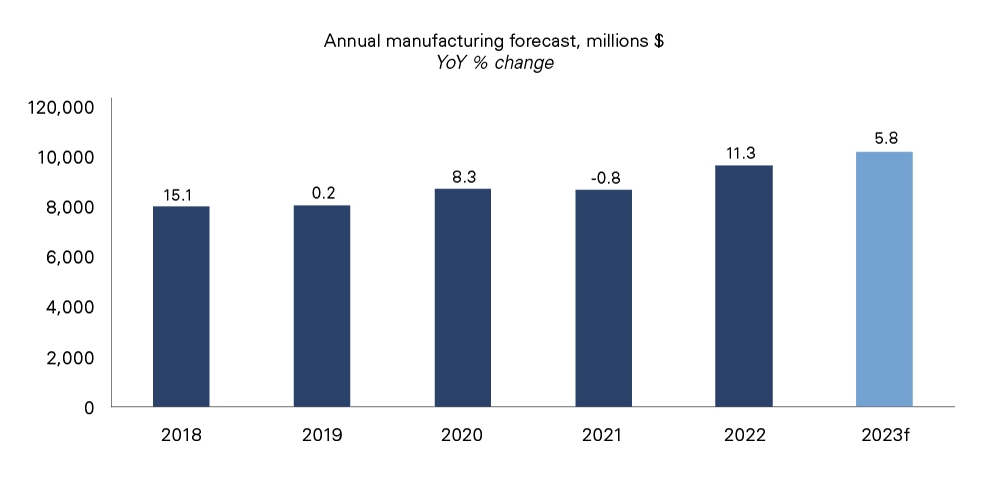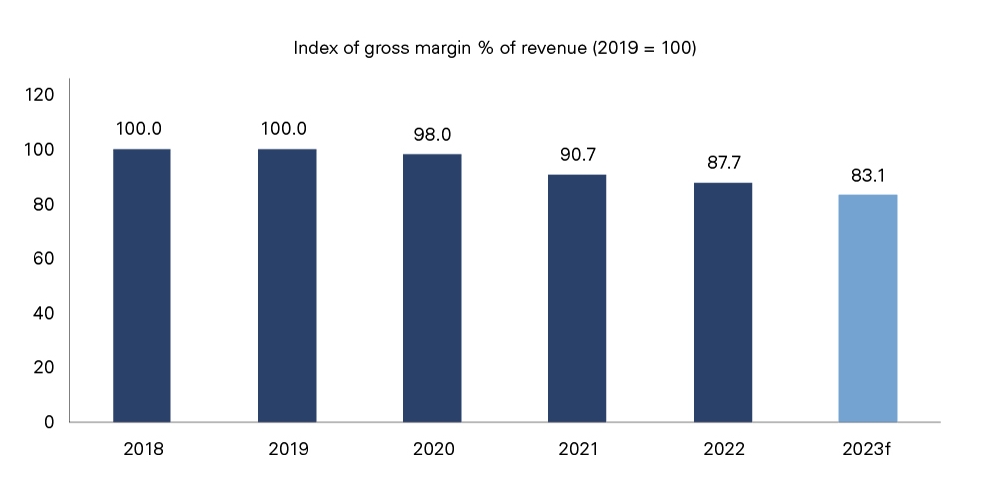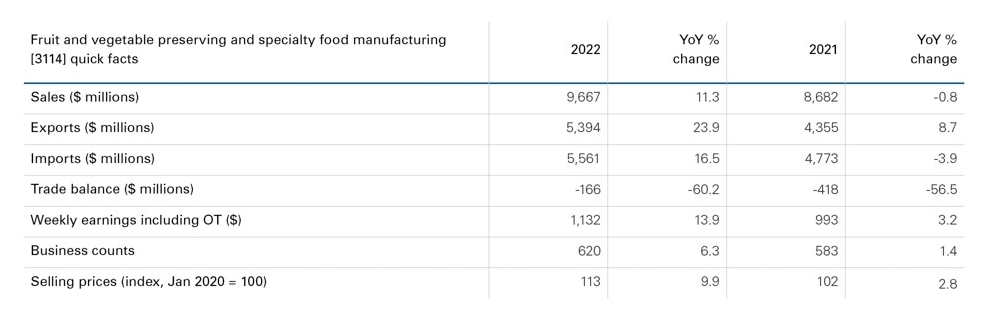2023 economic trends: Fruit and vegetable preserving and specialty food
Monday, July 17, 2023
Reference: FCC
 This information is shared from the 2023 FCC Food and Beverage Report – highlighting the opportunities and challenges for Canadian food manufacturers by industry. To get the bigger picture – read the full report.
This information is shared from the 2023 FCC Food and Beverage Report – highlighting the opportunities and challenges for Canadian food manufacturers by industry. To get the bigger picture – read the full report.Sales growth expected to be strong in 2023; margin pressure to continue
FCC Economics projects fruit and vegetable preserving and specialty food industry sales to increase 5.8% in 2023 (Figure C.1). This industry includes canned and frozen fruits/vegetables, baby food, french fries, soups, juice and specialty foods like frozen dinners/pizzas.Figure C.1: Fruit, vegetable and specialty food sales expected to increase 5.8% in 2023

Sources: FCC Economics, Statistics Canada, Barchart, Moody’s Analytics
Growth is expected to be strongest in the first half of 2023, growing around 8% YoY and building off strong sales in the second half of 2022. With consumer purchasing power tightening, sales of canned and preserved products have improved. Product innovation focused on healthy options will drive strong frozen foods sales. The Canadian exit of some imported Nestlé products could create opportunities for domestic manufacturers. With the cost of shipping frozen foods rising dramatically since the pandemic, we expect domestic sales to increase as more businesses look for local manufacturers with lower transportation costs.
While gross margins are forecasted to deteriorate further in 2023 (Figure C.2), we expect to see margin growth in the second half of the year. More frozen and specialty foods are in the market now than ever, and this increased competition has come with weaker margins. We expect margins to improve as penetrating pricing strategies on new products lessen and capital investments increase productivity. A caveat: the industry’s broad scope and continuous innovation make it difficult to compare profitability over time.
Figure C.2: Margins have steadily declined as the industry expands into higher volume categories

Sources: FCC Economics, Statistics Canada
How we got here: Shift from fresh to preserved
In 2021, customers preferred fresh produce and homemade meals because of pandemic apprehension and higher disposable incomes. Delivered home meal kit sales were strong, providing competition to this industry. In 2022, food inflation pushed consumers towards preserved foods and away from more expensive fresh foods. Sales increased 11% YoY in 2022 after declining 1% in 2021 (Table C.1). Price inflation was the biggest reason for the increase, rising just under 10% for the year.Table C.1: Sales rebounded in 2022 after a weaker 2021

Source: Statistics Canada
According to grocery data from Nielsen IQ, preserved fruit and vegetable products (canned, bottled, frozen, etc.) and frozen specialty food (frozen dinners, entrees, etc.) volumes declined. But they declined less than total food, and fresh food volumes fell. Volume growth improved within the industry as the year progressed, mostly from cheaper products with lower margins.
Margins were negatively impacted by consumers shifting to lower value-add products along with higher material and labour costs. Industry wages increased under 14% YoY, 4 percentage points more than the food manufacturing average.
Bottom line
- A focus on promoting convenience, nutritional enhancements and affordability will continue to attract consumers – an important consideration as households’ savings dissipates and consumer spending slows.
- With the market share of domestic Canadian manufacturers declining over 4% YoY in 2022, now representing less than 44% of total sales, opportunities exist to replace imported product market share.
Read More
Sign up to stay connected
- News
- Property Alerts
- Save your favourite properties
- And more!
Joining Farm Marketer is free, easy and you can opt out at any time.
